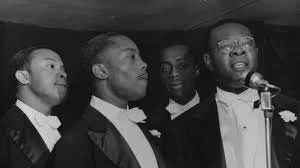The Golden Gate Quartet was a significant African American vocal group of the pre-rock era, rising to prominence in the 1930s and 1940s by blending gospel, spirituals, and popular vocal harmony into a style that influenced later genres like doo-wop, soul, and Motown. Known for their tight harmonies and engaging stage presence, the quartet was among the first gospel acts to gain widespread mainstream recognition.
Formed in the early 1930s in Norfolk, Virginia, the original members were students at Booker T. Washington High School. They gained early attention performing gospel and jubilee music, a style rooted in the African American spiritual tradition but presented with a more rhythmic, up-tempo, and often improvisational approach. Their arrangements combined bass vocal lines, percussive syllables, and close harmonies, expanding traditional gospel while maintaining its spiritual core.
The group began recording for Victor Records in 1937, and their popularity grew steadily. A key moment came in 1938 when producer John Hammond invited them to perform in the landmark “Spirituals to Swing” concert at Carnegie Hall. This event introduced them to a broader, more integrated audience and marked an early crossover of Black sacred music into secular performance venues.
In 1941, the Golden Gate Quartet signed with Columbia Records and appeared in several Hollywood films, including Star Spangled Rhythm (1942) and Hollywood Canteen (1944). These appearances increased their visibility during World War II, when American audiences were particularly receptive to music promoting unity, faith, and national spirit.
One of their notable recordings is the 1938 version of “Stormy Weather,” which showcases vocal techniques that would later be identified with doo-wop, a genre explored in more detail in a later chapter. Their smooth harmonies, dynamic shifts, and structured vocal parts—including bass leads and falsetto flourishes—anticipated the style of vocal groups that emerged in the 1950s and 1960s, especially during the Motown era.
Many Motown groups, such as The Temptations, The Four Tops, and The Miracles, drew from the musical structure and stage presence pioneered by the Golden Gate Quartet. The group’s balance of technical skill and emotional expression set a model for ensembles that followed, blending sacred and secular influences and expanding opportunities for Black vocal groups in popular music.
